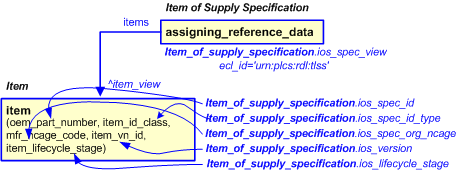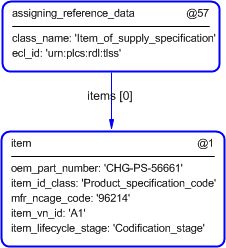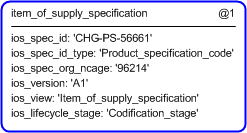Template:— item_of_supply_specification (itm_of_sply_spec)
Context:— UK_Defence |
Date: 2009/04/17 10:01:11
Revision: 1.2
|
This section specifies the template item_of_supply_specification.
NOTE
The template has been defined in the context of
UK_Defence.
Refer to the business context for details of related templates.
NOTE
An explanation of a template and the associated instantiation path is
provided in the
Template overview
section.
This template describes how to represent a specification which may be referenced within a cataloguing system or a system that
requires key information about a part for selection and ordering, but not the detailed information required to manufacture
it.
It is specifically based upon the 'item' template (which in turn is based upon the representing_part template), which is specialised
for (at least) one UK_Defence business DEX usage.
This particular template constrains the use of the 'item' template view to be a type of 'Item of support specification'.
This lifecycle stage is not defaulted to 'Codification stage' (for historical reasons), but is not fixed.
Most of the information about the item is attached via properties, documents, status assignments, effectivity and through
extending the reference data classes provided.
The EXPRESS-G diagram in
Figure
1
shows the templates and EXPRESS entities that are required
to represent the template
"item_of_supply_specification".
The text highlighted in blue shows the template parameters.
Figure 1 — An EXPRESS-G representation of the Information model for item_of_supply_specification
The graphic for the template to be used in other EXPRESS-G diagrams
is shown in Figure
2
below.
Figure 2 — The graphical representation of the item_of_supply_specification template
The following input parameters are defined for this template:
The type of identifier for the specification - is assumed to be Product_specification_code
The following classes and their sub-classes can be used:
classifications: [Product_specification_code]![[warning:]](../../../../../../images/dex/warning.gif) Error RDL4: The URI urn:plcs:rdl:uk_defence is not listed in dexlib/data/refdata/rdl_index.xml
Error RDL4: The URI urn:plcs:rdl:uk_defence is not listed in dexlib/data/refdata/rdl_index.xml
The ncage identifier of the organization (assumed to be a design authority) that provides/owns the specification
The version identifier of the item
ios_view (Default=Item_of_supply_specification,Type='CLASS')
The following classes and their sub-classes can be used:
The following reference parameters are defined for this template:
Allow the
Part
entity instantiated in this path to be referenced when this template is used.
Note: The
Part
entity can be referenced in a template path by:
%^target = $item_of_supply_specification.ios_specification%
where
target
is the parameter to which the
Part
is bound.
Allow the
Part_version
entity instantiated in this path to be referenced when this template is used.
Note: The
Part_version
entity can be referenced in a template path by:
%^target = $item_of_supply_specification.ios_spec_version%
where
target
is the parameter to which the
Part_version
is bound.
Allow the
Part_view_definition
entity instantiated in this path to be referenced when this template is used.
%^target = $item_of_supply_specification.ios_spec_view%
%^target = $item_of_supply_specification.ios_spec_contxt%
The instantiation path shown below specifies the entities that are to be
instantiated by the template.
A description of templates and the syntax for the instantiation path is
provided in the
Templates Help/Information section.
/
item(
oem_part_number=@ios_spec_id,
item_id_class=@ios_spec_id_type,
mfr_ncage_code=@ios_spec_org_ncage,
item_vn_id=@ios_version,
item_lifecycle_stage=@ios_lifecycle_stage)/
-- re-direct the output from the call.. %^ios_specification = $item.item%
%^ios_spec_version = $item.item_version%
%^ios_spec_view = $item.item_view%
%^ios_spec_contxt = $item.item_contxt%
-- provide the role of the item by classifying the item of supply view /
assigning_reference_data(
items=^ios_spec_view,
class_name=@ios_view,
ecl_id='urn:plcs:rdl:uk_defence')/
The instance diagram in Figure
3
shows an example of the EXPRESS entities and templates that are instantiated by the template:
/item_of_supply_specification(ios_spec_id='CHG-PS-56661', ios_spec_id_type='Product_specification_code', ios_spec_org_ncage='96214', ios_version='A1', ios_view='item_of_supply_specification', ios_lifecycle_stage='Codification_stage')/
(an illustration of the consolidated item_of_supply_specification template is shown in
Figure
4 below.)
Figure 3 — Entities instantiated by item_of_supply_specification template
The instance diagram in
Figure
4
shows the graphic symbol for the template that is to be
used in other instance diagrams. The example template is:
/item_of_supply_specification(ios_spec_id='CHG-PS-56661', ios_spec_id_type='Product_specification_code', ios_spec_org_ncage='96214', ios_version='A1', ios_view='item_of_supply_specification', ios_lifecycle_stage='Codification_stage')/
Figure 4 — Instantiation of item_of_supply_specification template
Characterizations
No common characterizations of the template
item_of_supply_specification
have been identified. However, the ISO 10303-239 EXPRESS model
may enable other assignments to the entities instantiated by the template.




